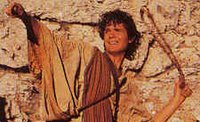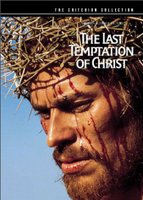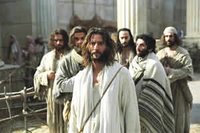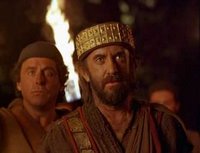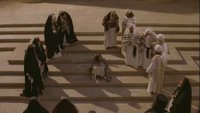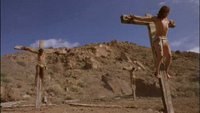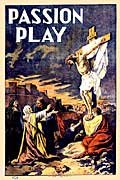
It's been said many times that Jesus didn't just arrive on earth simply as a man, but he came to first century Judea, as a first century Jewish man. Over the centuries, that incarnation has given artists of every age and race sufficient scope to bring Jesus to the people dressed in their own skin and culture. Mark Dornford-May's
Jezile (Son of Man), which sets the Jesus story in the context of a modern, anonymous African township, is the most recent addition to this rich history, and the first time such a re-contextualisation has been attempted in a film made outside North America.
There are three major challenges to such a project. Firstly, the actor playing Jesus has to be engaging and believable in the role, and this gets harder as the actors looks move further away from the disappointgly popular, floaty white robes, long hair and a beard stereotype. Andile Kosi, who plays Jesus, is almost the polar opposite of that stereotype - a short haired, shaven, black-African dressed in jeans and a checked shirt. Yet it is easy to relate to him in the role, not simply because he is the one doing the talking, but because he effortlessly blends strength and compassion, and an easy going nature with a compelling, passionate personality.
Secondly, the film has to draw creative and, more importantly, credible representatives of the key figures and events of the original story. If these don't ring true, or they feel too simulated, the whole project comes off as contrived. The creativity and initiative shown here is truly impressive managing to both embody the biblical narratives whilst also tearing through pious and kitsch tradition. The healing of a paralytic lowered through a roof feels far more natural than it ever did in any telling of this story set in the first century. Likewise, Herod's slaughter of the infants is brought uncomfortably close to home,

creating fear and tension even though we know Jesus's survival is assured.
Jezile also breathes new life into over-familiar bible characters. The shepherds are mere boys, as are the angels who appear to them. The disciples are drawn from both peaceful men (and women) and from freedom fighters who are challenged to lay down the weapons as well as their lives.
Following on from this is the third difficult area, namely that Jesus has to have something tangible to oppose that resonates with the film's audience.
Godspell for example, fizzles out just when the story should be starting to get interesting, simply because there is no such obvious opponent. When it comes to his big confrontation all they can find oppose him is a poorly made robot. Here however, the enemy is far more real. The backdrop of politics and corruption that leaves millions living in tin shacks around many African cities is something one cannot help but imagine that Jesus would oppose if he were around today, and it is hard not to imagine that those who benefit from this state of affairs would want to destroy anyone who threatened such a profitable status quo. Pilate's troops masquerade as agents of peace from a neighbouring country, maintaining their power by manipulating local gangland leaders Caiaphas and Annas.
Finally, the film has to work well as a film, and it is this area in particular that has seen the film gain such strong praise from those who saw it at Sundance. Whilst Dornford-May primarily has a background in theatre, he has quickly adjusted to his new medium. He uses a variety of techniques to bring the film that bit closer to modern viewers, including shooting some of the film's narration in the style of news footage, and showing other scenes, in particular the supernatural elements, as shot through a camcorder. That said, he blends them well with more naturalistic, and intimate footage to prevent them becoming gimmicky, or the film becoming too much of a documentary. Dornford-May also allows the camera to dwell on the incredible scenery that surrounds the townships, comparing the beauty of God's creation with the unsightly shacks that humanity has left some of its members to live in.

One of the other things Dornford-May attempts is re-inventing key works of Christian painting. So early on we see Jesus as a child sat on Mary's knee, wearing a party hat crown. The film dwells on this motionless scene for several seconds. Likewise after Jesus's death, Mary (played by the director's wife and co-writer Pauline Malefane) holds his body in the traditional "Pieta" pose, only here they are on the back of a truck driving along the road.
The film also comments on the way Jesus's activity was recorded and preserved for a wider audience. As noted above Jesus's miracles are recorded on camcorder by Judas, and used as evidence against him. Conversely, Jesus's actions start to be recorded and celebrated in murals on walls in the townships, disseminating the stories about him into accessible "language", and announcing them to a wider audience. As a result Jesus's popularity grows, and he begins to pose more of a threat to those in power.
At this point, everyone in the audience knows Jesus's days are numbered, and it's no real surprise when Jesus is arrested shortly after sharing a final meal with his followers. What is surprising however is his crucifixion and death. (Readers wanting to avoid spoilers are advised to move onto the next paragraph). Jesus, like so many anti-apartheid leaders before him, is beaten to death, and buried in a shallow grave. In South Africa, the families of those murdered in a similar way eventually decided to break a strongly held African taboo and display their dead bodies for all to see. In so doing, they were able to show that their loved ones had not simply had an unfortunate accident, as the authorities often claimed, but had clearly been murdered. So the film reflects this later tradition.

Once Jesus's body is found, it is his friends and family that tie Jesus's dead body to the cross. Christian theology has often held that the cross declares to the (spiritual) powers that be that their days are numbered. This crucifixion makes a similar declaration to the
political powers.
It's a political end to a very politically charged version of the Christ story. Whilst the film has no real doubts about Jesus's divinity - showing a number of miracles, prayers and confrontations with Satan, it is the political aspect of Jesus's brief time on earth that is of most concern. Many European and American Christians, living in a culture where religion and theology have been almost totally separated, will not be entirely comfortable with this. Yet Jesus's core belief in this film is that "This is my world" - a statement that is both political
and theological . Likewise, when the early Christians claimed Jesus was King and Lord of all the world, they also meant that therefore Caesar wasn't. Such radical, political statements lie at the hearts of
Son of Man, and we ignore them, and it, at our peril.
Labels: African Bible Films, Jezile (Son of Man 2006)
 Peter Chattaway has linked to Christianity Today's interview with Mike Rich - the writer for The Nativity Story. There are a few new things to comment on. Firstly, it appears that Rich's image has changed somewhat. The best photo of him available back in February was this one, where he looked more like an Evangelical Christian trying to be a writer than the accomplished film writer he actually was. His "new" look (because it might just have been an old / bad photo) is much better. Perhaps I'm being fickle here, but this small detail in itself increases my (already fairly buoyant) optimism about the film.
Peter Chattaway has linked to Christianity Today's interview with Mike Rich - the writer for The Nativity Story. There are a few new things to comment on. Firstly, it appears that Rich's image has changed somewhat. The best photo of him available back in February was this one, where he looked more like an Evangelical Christian trying to be a writer than the accomplished film writer he actually was. His "new" look (because it might just have been an old / bad photo) is much better. Perhaps I'm being fickle here, but this small detail in itself increases my (already fairly buoyant) optimism about the film. 















